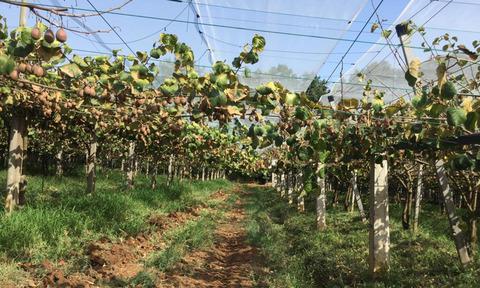当前位置:
X-MOL 学术
›
Plant Pathol.
›
论文详情
Our official English website, www.x-mol.net, welcomes your
feedback! (Note: you will need to create a separate account there.)
Clostridium bifermentans and C. subterminale are associated with kiwifruit vine decline, known as “moria”, in Italy
Plant Pathology ( IF 2.3 ) Pub Date : 2020-05-01 , DOI: 10.1111/ppa.13161 Patrizia Spigaglia 1 , Fabrizio Barbanti 1 , Fabio Marocchi 2 , Marco Mastroleo 2 , Marco Baretta 2 , Patrizia Ferrante 3 , Emilia Caboni 3 , Simona Lucioli 3 , Marco Scortichini 3
Plant Pathology ( IF 2.3 ) Pub Date : 2020-05-01 , DOI: 10.1111/ppa.13161 Patrizia Spigaglia 1 , Fabrizio Barbanti 1 , Fabio Marocchi 2 , Marco Mastroleo 2 , Marco Baretta 2 , Patrizia Ferrante 3 , Emilia Caboni 3 , Simona Lucioli 3 , Marco Scortichini 3
Affiliation

|
Since 2012, a new pathogenic syndrome has frequently been observed in many areas of kiwifruit cultivation in Italy. The main symptoms include an initial withering of the leaves followed by a total and sudden collapse of plants, mainly occurring during summer. The withered leaves fall and the main and secondary feeder roots appear rotten, sometimes showing a reddish‐brown discoloration. The disease, that affects both the green and yellow‐fleshed cultivars, has been called kiwifruit vine decline and is locally known as moria. The syndrome has been found consistently associated with soil waterlogging, which frequently occurs either after the traditional agronomical practice of irrigating orchards through surface irrigation or after very heavy rainfall. So far, the role played by bacteria in this syndrome has not been investigated. In the present study, Clostridium spp. were isolated from both rotten roots and soils obtained from Italian kiwifruit orchards affected by the syndrome, indicating for the first time that anaerobic bacteria are able to cause damage to woody crops. C. bifermentans and C. subterminale incited symptoms in kiwifruit in both in vivo and in vitro pathogenicity tests. Soil waterlogging seems to potentially favour colonization of kiwifruit roots by anaerobic bacteria, probably because saturation of the soil can facilitate proliferation and persistence of these bacteria during long periods of the vegetative growth of the crop. The occurrence of anaerobic bacteria does not exclude the possibility that other microorganisms can play additional/synergic role(s) in causing the kiwifruit vine decline.
中文翻译:

Clostridium bifermentans 和 C. subterminale 与奇异果藤蔓衰退有关,在意大利被称为“moria”
2012年以来,意大利多个猕猴桃种植区频频出现新的致病综合征。主要症状包括最初的叶子枯萎,然后是植物的完全和突然倒塌,主要发生在夏季。枯叶落下,主要和次要的饲养根出现腐烂,有时呈现红褐色变色。这种影响绿色和黄色果肉品种的病害被称为猕猴桃藤蔓衰退病,在当地被称为moria。该综合征一直被发现与土壤涝渍有关,这经常发生在通过地表灌溉灌溉果园的传统农艺实践之后或在大雨之后。迄今为止,尚未研究细菌在该综合征中所起的作用。在本研究中,梭菌属。从受该综合征影响的意大利猕猴桃园中获得的腐烂根和土壤中分离出细菌,首次表明厌氧菌能够对木本作物造成损害。在体内和体外致病性测试中,C. bifermentans 和 C. subterminale 在猕猴桃中引起症状。土壤涝渍似乎有利于猕猴桃根被厌氧细菌定殖,这可能是因为土壤的饱和可以促进这些细菌在作物长期营养生长期间的增殖和持续存在。厌氧菌的出现并不排除其他微生物可以在导致猕猴桃藤蔓衰退方面发挥额外/协同作用的可能性。从受该综合征影响的意大利猕猴桃园中获得的腐烂根和土壤中分离出细菌,首次表明厌氧菌能够对木本作物造成损害。在体内和体外致病性测试中,C. bifermentans 和 C. subterminale 在猕猴桃中引起症状。土壤涝渍似乎有利于猕猴桃根被厌氧细菌定殖,这可能是因为土壤的饱和可以促进这些细菌在作物长期营养生长期间的增殖和持续存在。厌氧菌的出现并不排除其他微生物可以在导致猕猴桃藤蔓衰退方面发挥额外/协同作用的可能性。从受该综合征影响的意大利猕猴桃园中获得的腐烂根和土壤中分离出细菌,首次表明厌氧菌能够对木本作物造成损害。在体内和体外致病性测试中,C. bifermentans 和 C. subterminale 在猕猴桃中引起症状。土壤涝渍似乎有利于猕猴桃根被厌氧细菌定殖,这可能是因为土壤的饱和可以促进这些细菌在作物长期营养生长期间的增殖和持续存在。厌氧菌的出现并不排除其他微生物可以在导致猕猴桃藤蔓衰退方面发挥额外/协同作用的可能性。首次表明厌氧菌能够对木本作物造成损害。在体内和体外致病性测试中,C. bifermentans 和 C. subterminale 在猕猴桃中引起症状。土壤涝渍似乎有利于猕猴桃根被厌氧细菌定殖,这可能是因为土壤的饱和可以促进这些细菌在作物长期营养生长期间的增殖和持续存在。厌氧菌的出现并不排除其他微生物可以在导致猕猴桃藤蔓衰退方面发挥额外/协同作用的可能性。首次表明厌氧菌能够对木本作物造成损害。在体内和体外致病性测试中,C. bifermentans 和 C. subterminale 在猕猴桃中引起症状。土壤涝渍似乎有利于猕猴桃根被厌氧细菌定殖,这可能是因为土壤的饱和可以促进这些细菌在作物长期营养生长期间的增殖和持续存在。厌氧菌的出现并不排除其他微生物可以在导致猕猴桃藤蔓衰退方面发挥额外/协同作用的可能性。土壤涝渍似乎有利于猕猴桃根被厌氧细菌定殖,这可能是因为土壤的饱和可以促进这些细菌在作物长期营养生长期间的增殖和持续存在。厌氧菌的出现并不排除其他微生物可以在导致猕猴桃藤蔓衰退方面发挥额外/协同作用的可能性。土壤涝渍似乎有利于猕猴桃根被厌氧细菌定殖,这可能是因为土壤的饱和可以促进这些细菌在作物长期营养生长期间的增殖和持续存在。厌氧菌的出现并不排除其他微生物可以在导致猕猴桃藤蔓衰退方面发挥额外/协同作用的可能性。
更新日期:2020-05-01
中文翻译:

Clostridium bifermentans 和 C. subterminale 与奇异果藤蔓衰退有关,在意大利被称为“moria”
2012年以来,意大利多个猕猴桃种植区频频出现新的致病综合征。主要症状包括最初的叶子枯萎,然后是植物的完全和突然倒塌,主要发生在夏季。枯叶落下,主要和次要的饲养根出现腐烂,有时呈现红褐色变色。这种影响绿色和黄色果肉品种的病害被称为猕猴桃藤蔓衰退病,在当地被称为moria。该综合征一直被发现与土壤涝渍有关,这经常发生在通过地表灌溉灌溉果园的传统农艺实践之后或在大雨之后。迄今为止,尚未研究细菌在该综合征中所起的作用。在本研究中,梭菌属。从受该综合征影响的意大利猕猴桃园中获得的腐烂根和土壤中分离出细菌,首次表明厌氧菌能够对木本作物造成损害。在体内和体外致病性测试中,C. bifermentans 和 C. subterminale 在猕猴桃中引起症状。土壤涝渍似乎有利于猕猴桃根被厌氧细菌定殖,这可能是因为土壤的饱和可以促进这些细菌在作物长期营养生长期间的增殖和持续存在。厌氧菌的出现并不排除其他微生物可以在导致猕猴桃藤蔓衰退方面发挥额外/协同作用的可能性。从受该综合征影响的意大利猕猴桃园中获得的腐烂根和土壤中分离出细菌,首次表明厌氧菌能够对木本作物造成损害。在体内和体外致病性测试中,C. bifermentans 和 C. subterminale 在猕猴桃中引起症状。土壤涝渍似乎有利于猕猴桃根被厌氧细菌定殖,这可能是因为土壤的饱和可以促进这些细菌在作物长期营养生长期间的增殖和持续存在。厌氧菌的出现并不排除其他微生物可以在导致猕猴桃藤蔓衰退方面发挥额外/协同作用的可能性。从受该综合征影响的意大利猕猴桃园中获得的腐烂根和土壤中分离出细菌,首次表明厌氧菌能够对木本作物造成损害。在体内和体外致病性测试中,C. bifermentans 和 C. subterminale 在猕猴桃中引起症状。土壤涝渍似乎有利于猕猴桃根被厌氧细菌定殖,这可能是因为土壤的饱和可以促进这些细菌在作物长期营养生长期间的增殖和持续存在。厌氧菌的出现并不排除其他微生物可以在导致猕猴桃藤蔓衰退方面发挥额外/协同作用的可能性。首次表明厌氧菌能够对木本作物造成损害。在体内和体外致病性测试中,C. bifermentans 和 C. subterminale 在猕猴桃中引起症状。土壤涝渍似乎有利于猕猴桃根被厌氧细菌定殖,这可能是因为土壤的饱和可以促进这些细菌在作物长期营养生长期间的增殖和持续存在。厌氧菌的出现并不排除其他微生物可以在导致猕猴桃藤蔓衰退方面发挥额外/协同作用的可能性。首次表明厌氧菌能够对木本作物造成损害。在体内和体外致病性测试中,C. bifermentans 和 C. subterminale 在猕猴桃中引起症状。土壤涝渍似乎有利于猕猴桃根被厌氧细菌定殖,这可能是因为土壤的饱和可以促进这些细菌在作物长期营养生长期间的增殖和持续存在。厌氧菌的出现并不排除其他微生物可以在导致猕猴桃藤蔓衰退方面发挥额外/协同作用的可能性。土壤涝渍似乎有利于猕猴桃根被厌氧细菌定殖,这可能是因为土壤的饱和可以促进这些细菌在作物长期营养生长期间的增殖和持续存在。厌氧菌的出现并不排除其他微生物可以在导致猕猴桃藤蔓衰退方面发挥额外/协同作用的可能性。土壤涝渍似乎有利于猕猴桃根被厌氧细菌定殖,这可能是因为土壤的饱和可以促进这些细菌在作物长期营养生长期间的增殖和持续存在。厌氧菌的出现并不排除其他微生物可以在导致猕猴桃藤蔓衰退方面发挥额外/协同作用的可能性。











































 京公网安备 11010802027423号
京公网安备 11010802027423号